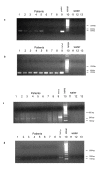Mouse DNA contamination in human tissue tested for XMRV
- PMID: 21171966
- PMCID: PMC3019155
- DOI: 10.1186/1742-4690-7-108
Mouse DNA contamination in human tissue tested for XMRV
Abstract
Background: We used a PCR-based approach to study the prevalence of genetic sequences related to a gammaretrovirus, xenotropic murine leukemia virus-related virus, XMRV, in human prostate cancer. This virus has been identified in the US in prostate cancer patients and in those with chronic fatigue syndrome. However, with the exception of two patients in Germany, XMRV has not been identified in prostate cancer tissue in Europe. Most putative associations of new or old human retroviruses with diseases have turned out to be due to contamination. We have looked for XMRV sequences in DNA extracted from formalin-fixed paraffin- embedded prostate tissues. To control for contamination, PCR assays to detect either mouse mitochondrial DNA (mtDNA) or intracisternal A particle (IAP) long terminal repeat DNA were run on all samples, owing to their very high copy number in mouse cells.
Results: In general agreement with the US prevalence, XMRV-like sequences were found in 4.8% of prostate cancers. However, these were also positive, as were 21.5% of XMRV-negative cases, for IAP sequences, and many, but not all were positive for mtDNA sequences.
Conclusions: These results show that contamination with mouse DNA is widespread and detectable by the highly sensitive IAP assay, but not always with less sensitive assays, such as murine mtDNA PCR. This study highlights the ubiquitous presence of mouse DNA in laboratory specimens and offers a means of rigorous validation for future studies of murine retroviruses in human disease.
Figures


Similar articles
-
Contamination of human DNA samples with mouse DNA can lead to false detection of XMRV-like sequences.Retrovirology. 2010 Dec 20;7:109. doi: 10.1186/1742-4690-7-109. Retrovirology. 2010. PMID: 21171973 Free PMC article.
-
No association between XMRV or related gammaretroviruses in Australian prostate cancer patients.Virol J. 2013 Jan 10;10:20. doi: 10.1186/1743-422X-10-20. Virol J. 2013. PMID: 23305518 Free PMC article.
-
Disease-associated XMRV sequences are consistent with laboratory contamination.Retrovirology. 2010 Dec 20;7(1):111. doi: 10.1186/1742-4690-7-111. Retrovirology. 2010. PMID: 21171979 Free PMC article.
-
Recombinant origin, contamination, and de-discovery of XMRV.Curr Opin Virol. 2012 Aug;2(4):499-507. doi: 10.1016/j.coviro.2012.06.009. Epub 2012 Jul 19. Curr Opin Virol. 2012. PMID: 22818188 Free PMC article. Review.
-
Lack of evidence for a role of xenotropic murine leukemia virus-related virus in the pathogenesis of prostate cancer and/or chronic fatigue syndrome.Virus Res. 2012 Jul;167(1):1-7. doi: 10.1016/j.virusres.2012.04.004. Epub 2012 Apr 15. Virus Res. 2012. PMID: 22531412 Review.
Cited by
-
Human saliva as route of inter-human infection for mouse mammary tumor virus.Oncotarget. 2015 Jul 30;6(21):18355-63. doi: 10.18632/oncotarget.4567. Oncotarget. 2015. PMID: 26214095 Free PMC article.
-
Microbial Community Responses to Increased Water and Organic Matter in the Arid Soils of the McMurdo Dry Valleys, Antarctica.Front Microbiol. 2016 Jul 18;7:1040. doi: 10.3389/fmicb.2016.01040. eCollection 2016. Front Microbiol. 2016. PMID: 27486436 Free PMC article.
-
What can academia learn from XMRV studies?Nat Rev Urol. 2012 Feb 14;9(3):174; author reply 174. doi: 10.1038/nrurol.2011.225-c1. Nat Rev Urol. 2012. PMID: 22331091 Free PMC article. No abstract available.
-
Serologic and PCR testing of persons with chronic fatigue syndrome in the United States shows no association with xenotropic or polytropic murine leukemia virus-related viruses.Retrovirology. 2011 Feb 22;8:12. doi: 10.1186/1742-4690-8-12. Retrovirology. 2011. PMID: 21342521 Free PMC article.
-
Prevalence of XMRV nucleic acid and antibody in HIV-1-Infected men and in men at risk for HIV-1 Infection.Adv Virol. 2011;2011:268214. doi: 10.1155/2011/268214. Epub 2011 Nov 21. Adv Virol. 2011. PMID: 22282703 Free PMC article.
References
-
- Urisman A, Molinaro RJ, Fisher N, Plummer SJ, Casey G, Klein EA, Malathi K, Magi-Galluzzi C, Tubbs RR, Ganem D, Silverman RH, DeRisi JL. Identification of a novel gammaretrovirus in prostate tumors of patients homozygous for R462Q RNASEL variant. PLos Pathog. 2006;2:211–225. doi: 10.1371/journal.ppat.0020025. - DOI - PMC - PubMed
-
- Danielson BP, Ayala GE, Kimata JT. Detection of Xenotropic Murine Leukemia Virus-Related Virus in Normal and Tumor Tissue of Patients from the Southern United States with Prostate Cancer is Dependent on Specific Polymerase Chain Reaction Conditions. J Inf Dis. 2010;202:1470–1477. doi: 10.1086/656146. - DOI - PMC - PubMed
-
- Hong S, Klein EA, Das Gupta J, Hanke K, Weight CJ, Nguyen C, Gaughan C, Kim KA, Bannert N, Kirchhoff F, Munch J, Silverman RH. Fibrils of prostatic acid phosphatase fragments boost infections with XMRV (xenotropic murine leukaemia virus-related virus), a human retrovirus associated with prostate cancer. J Virol. 2009;83(14):6995–7003. doi: 10.1128/JVI.00268-09. - DOI - PMC - PubMed
-
- Arnold RS, Makarova NV, Osunkoya AO, Suppiah S, Scott TA, Johnson NA, Bhosle SM, Liotta D, Hunter E, Marshall FF, Ly H, Molinaro RJ, Blackwell JL, Petros JA. XMRV infection in patients with prostate cancer: novel serologic assay and correlation with PCR and FISH. Urology. 2010;75(4):755–61. doi: 10.1016/j.urology.2010.01.038. - DOI - PubMed
Publication types
MeSH terms
Substances
Grants and funding
LinkOut - more resources
Full Text Sources
Other Literature Sources
Medical
Research Materials

